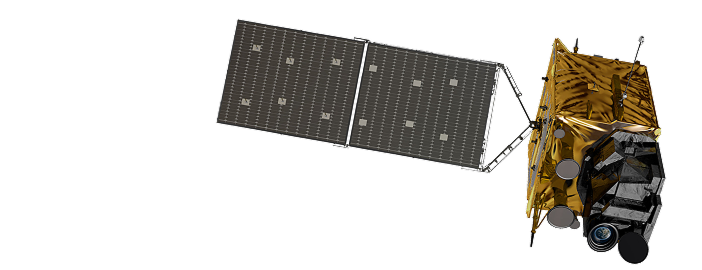



The meteorological imager(MI) mounted on Cheollian 1 generates black and white images with one visible band and four infrared(IR) bands. The resolution of the visible and IR bands is 1km and 4km, respectively. It takes 30 minutes for Full Disk observation and 2 minutes for observation on the Korean Peninsula. With the images observed by MI, 16 types of meteorological outputs are generated through the meteorological data processing system of the National Meteorological Satellite Center. As the follow-on satellite of Cheollian 1, Cheollian 2A is a geostationary satellite to observe constantly the Earth weather over and surrounding the Korean Peninsula, as well as space weather. Equipped with the advanced meteorological imager (AMI), it exhibits the world best performance equivalent to the meteorological payload of GOES-16 and GOES-17 from the United States and Himawari-8 and Himawari-9 from Japan.
Cheollian 2A’s meteorological payload(AMI) observes Earth weather with 4 visible bands and 12 IR bands to make true color images generated. The resolution of visible and IR bands is 0.5-1 km and 2 km, respectively. The AMI can perform 1 Full Disk observation, 5 East Asian regional observations, and 5 Korean peninsula observations in 10 minutes. The transmission rate of observation data is 115Mb per second which is 18 times faster than MI of Cheollian 1. Since color images allow tracking of various substances, such as yellow sand and volcanic ash, by type, the meteorological data processing system of Cheollian 2A can produce 52 types of meteorological outputs, which is three times those of Cheollian 1.
With Cheollian 2A meteorological outputs, it is possible to provide in a timely manner, accurate and various weather data closely related to people's living, such as basic not only precipitation and snowfall, but also the effects of fine dust (aerosol), yellow sand, ozone, and volcanic ash on the atmosphere(detection of concentration at different altitudes).
| Subject | Cheollian 1 | Cheollian 2A | Remarks | |
|---|---|---|---|---|
| Number of observation channels | 5 channels (1 visible and 4 IR) | 16 channels (4 visible, 2 near IR, and 10 IR) | 3 times faster | |
| Black&Whire | RGB true color | |||
| Spatial resolution | Visible image | 1km | 0.5~1km | 4 times enhanced |
| IR | 4km | 2km | ||
| Observation interval | Full Disk observation | 3 hours | 10 minutes | 6 times faster |
| Asia | - | 2 minutes | ||
| Korean Peninsula | About 8 times/hour | About 30 times/hour | ||
| Basic weather output | 16 types | 52 types | 3.5 times larger | |